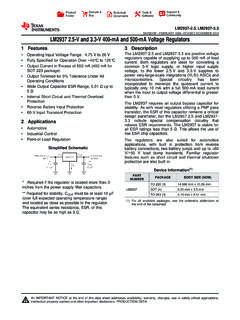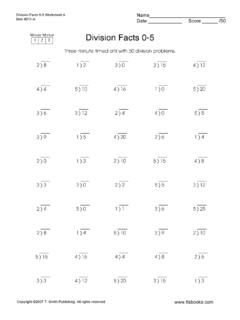Transcription of North Carolina Essential Standards 3-5 Science
1 North Carolina Essential Standards 3- 5 science Note on Numbering: Physical Science (P) Earth Science (E) Life Science (L). The North Carolina Science Essential Standards maintain the respect for local control of each Local Education Authority (LEA) to design the specific curricular and instructional strategies that best deliver the content to their students. Nonetheless, engaging students in inquiry-based instruction is a critical way of developing conceptual understanding of the Science content that is vital for success in the twenty-first century. The process of scientific inquiry, experimentation and technological design should not be taught nor tested in isolation of the core concepts drawn from physical Science , earth Science and life Science .
2 A seamless integration of Science content, scientific inquiry, experimentation and technological design will reinforce in students the notion that "what" is known is inextricably tied to "how" it is known. A well-planned Science curriculum provides opportunities for inquiry, experimentation and technological design. Teachers, when teaching Science , should provide opportunities for students to engage in "hands-on/minds-on" activities that are exemplars of scientific inquiry, experimentation and technological design. 3rd Grade Science as Inquiry As students progress through the grade levels, their strategies for finding solutions to questions improve as they gain experience conducting simple investigations and working in small groups.
3 They are capable of asking questions and make predictions that can be tested. Students must be encouraged to make more careful observations and measure things with increasing accuracy. During investigations, students must have opportunity to use more advanced tools such as calculators, computers, graduated cylinders, scales and meter sticks to gather data and extend their senses. They must keep accurate records and run enough trials to be confident of their results to test a prediction. They must have experiences that allow them to recognize patterns in data and use data to create reasonable explanations of results of an experiment or investigation.
4 They should be encouraged to employ more sophisticated language, drawings, models, charts and graphs to communicate results and explanations. Students must always use appropriate safety procedures, including listening skills, when conducting simple investigations. Forces and Motion Essential Standard Clarifying Objectives Understand motion and factors Infer changes in speed or direction resulting from forces acting that affect motion. on an object. Compare the relative speeds (faster or slower) of objects that travel the same distance in different amounts of time.
5 Explain the effects of earth's gravity on the motion of any object on or near the earth. North Carolina Essential Standards 3- 5 science Matter: Properties and Change Essential Standard Clarifying Objectives Understand the structure and Recognize that air is a substance that surrounds us, takes up properties of matter before and space and has mass. after they undergo a change. Compare solids, liquids, and gases based on their basic properties. Summarize changes that occur to the observable properties of materials when different degrees of heat are applied to them, such as melting ice or ice cream, boiling water or an egg, or freezing water.
6 Energy: Conservation and Transfer Essential Standard Clarifying Objectives Recognize how energy can be Recognize that energy can be transferred from one object to transferred from one object to another by rubbing them against each other. another. Recognize that energy can be transferred from a warmer object to a cooler one by contact or at a distance and the cooler object gets warmer. Earth in the Universe Essential Standard Clarifying Objectives Recognize the major Recognize that the earth is part of a system called the solar components and patterns system that includes the sun (a star), planets, and many moons observed in the earth/moon/sun and the earth is the third planet from the sun in our solar system.
7 System. Recognize that changes in the length and direction of an object's shadow indicate the apparent changing position of the Sun during the day although the patterns of the stars in the sky, to include the Sun, stay the same. North Carolina Essential Standards 3- 5 science Earth Systems, Structures and Processes Essential Standard Clarifying Objectives Compare the structures of the Compare Earth's saltwater and freshwater features (including Earth's surface using models or oceans, seas, rivers, lakes, ponds, streams, and glaciers). three-dimensional diagrams.
8 Compare Earth's land features (including volcanoes, mountains, valleys, canyons, caverns, and islands) by using models, pictures, diagrams, and maps. Structures and Functions of Living Organisms Essential Standard Clarifying Objectives Understand human body Compare the different functions of the skeletal and muscular systems and how they are system. Essential for life: protection, Explain why skin is necessary for protection and for the body movement and support. to remain healthy. Ecosystems Essential Standard Clarifying Objectives Understand how plants survive Remember the function of the following structures as it relates in their environments.
9 To the survival of plants in their environments: Roots absorb nutrients Stems provide support Leaves synthesize food Flowers attract pollinators and produce seeds for reproduction Explain how environmental conditions determine how well plants survive and grow. Summarize the distinct stages of the life cycle of seed plants. Explain how the basic properties (texture and capacity to hold water) and components (sand, clay and humus) of soil determine the ability of soil to support the growth and survival of many plants. North Carolina Essential Standards 3- 5 science 4th Grade Science as Inquiry As students progress through the grade levels, their strategies for finding solutions to questions improve as they gain experience conducting simple investigations and working in small groups.
10 They are capable of asking questions and make predictions that can be tested. Students must be encouraged to make more careful observations and measure things with increasing accuracy. During investigations, students must have opportunity to use more advanced tools such as calculators, computers, graduated cylinders, scales and meter sticks to gather data and extend their senses. They must keep accurate records and run enough trials to be confident of their results to test a prediction. They must have experiences that allow them to recognize patterns in data and use data to create reasonable explanations of results of an experiment or investigation.















